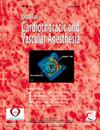机器人心脏手术中连续脊柱后凸平面阻滞的阿片类药物节约效应:随机临床试验的初步结果
IF 2.3
4区 医学
Q2 ANESTHESIOLOGY
Journal of cardiothoracic and vascular anesthesia
Pub Date : 2024-10-25
DOI:10.1053/j.jvca.2024.09.038
引用次数: 0
摘要
目的许多研究小组已证明机器人心脏手术(RCS)是可行和安全的。在微创心脏手术中,局部麻醉(LRA)已被证明能改善术后疼痛控制。针对 RCS,最佳的 LRA 技术尚未确定。本研究旨在评估连续性单侧 ESP 阻滞对 RCS 术后疼痛控制的有益影响。干预将患者随机分为 "ESP "组和 "对照 "组,"ESP "组接受ESP阻滞(术中负荷剂量为20毫升,然后持续输注0.2%罗哌卡因24小时),"对照 "组接受常规围术期疼痛治疗(持续静脉输注吗啡)。此外,所有患者都接受了多模式镇痛,包括对乙酰氨基酚、地塞米松和由患者控制的静脉注射吗啡镇痛。次要结果为术后 6、12、24 和 48 小时的数字评分量表(NRS)疼痛评分。但有 24 名患者因各种原因退出了试验。主要原因包括无法评估镇痛效果(5 例)、癫痫发作(3 例)和其他问题(16 例),如导管功能障碍或移除、再次改为胸骨切开术和术后出血。干预组所有患者均成功实施了ESP阻滞,未观察到任何围手术期不良反应。与对照组相比,ESP组的阿片类药物用量呈下降趋势,术后12小时的吗啡用量差异显著(p = 0.049,表1和图1)。表 1:ESP 组与对照组术后阿片类药物用量比较。表 1:ESP 组与对照组术后阿片类药物消耗量比较,数据以中位数(四分位数间距)表示。表 2:ESP 组与对照组术后疼痛的比较,数据以中位数(四分位距)表示。与传统的多模式镇痛相比,该技术可改善围术期疼痛管理,减少阿片类药物的用量,尤其是在术后第一阶段。如果完整研究样本的分析结果得到验证,这些初步研究结果表明,在接受脊髓造影术的患者中,连续ESP阻滞可被视为一种经济实惠的阿片类药物节省策略。本文章由计算机程序翻译,如有差异,请以英文原文为准。
Opioid-sparing effect of Continuous Erector Spinae Plane Block in Robotic Cardiac Surgery: Preliminary Results of a Randomized Clinical Trial
Objective
Robotic cardiac surgery (RCS) has been demonstrated to be feasible and safe by many groups. Several studies reported better outcomes of RCS (lower complication rate, reduced length of stay, improved quality of life) compared to non-robotic technique In minimally invasive cardiac surgery locoregional aneasthesia (LRA) has been demonstrated to improve postoperative pain control. Specific to RCS, the optimal LRA technique has yet to be determined. Erector spinae plane (ESP) block is an easy-to-perform technique that can provide an adequate pain control in chest surgery, reducing the postoperative dose of opioids.
The aim of the present study is to assess the beneficial effects of continuous unilateral ESP block in the management of the postoperative pain after RCS.
Design and method
Design
A randomized controlled trial.
Setting
Single-center, university tertiary-care institution.
Participants
Patients undergoing non-coronary robotic-assisted cardiac surgery.
Interventions
Patients were randomized to the “ESP” group, receiving an ESP block (intraoperative loading dose of 20 ml followed by continuous infusion of ropivacaine 0.2% for 24 hours) versus “control” group, receiving conventional perioperative pain management (continuous infusion of intravenous morphine). In addition, all patients received multimodal analgesia including acetaminophen, dexamethasone and patient-controlled analgesia with intravenous morphine.
Measurements
The primary outcomes were morphine consumption at 12 and 24 hours, as well as the total postoperative dose. The secondary outcomes were pain scores on a Numeric Rating Scale (NRS) at 6, 12, 24, and 48 hours after surgery.
Results and conclusions
Main Results
Fifty-four patients were randomized. However, 24 patients were withdrawn from the trial for various reasons. The main reasons included inability to assess analgesia (n=5), seizures (n=3), and other issues (n=16), such as catheter dysfunction or removal, reconversion to sternotomy, and postoperative bleeding. The data from the remaining 30 patients were analysed appropriately.
ESP block was successfully performed in all patients in the intervention group without observing any perioperative adverse effects. In comparison with the control group, a trend of lower opioid consumption was observed in the ESP group, with a significant difference in morphine use 12 hours after surgery (p = 0.049, Table 1 and Figure 1). No difference was observed in postoperative pain scores measured by the NRS (Table 2 and Figure 2).
Table 1: Comparison of the postoperative opioid consumption between ESP group and control group. Data expressed as median (interquartile range).
Figure 1: Box-plot representing the data of Table 1.
Table 2: Comparison of the postoperative pain between ESP group and control group. Data expressed as median (interquartile range).
Figure 2: Box-plot representing the data of Table 2.
Conclusion
In RCS continuous ESP block is a safe and feasible, providing an adequate pain relief. Compared to conventional multimodal analgesia, this technique can improve perioperative pain management decreasing opioid consumption, especially during the first postoperative period. If validated by the analysis of the complete study sample, these preliminary findings suggest that continuous ESP block could be considered an affordable opioid-sparing strategy in patients undergoing RCS.
求助全文
通过发布文献求助,成功后即可免费获取论文全文。
去求助
来源期刊
CiteScore
4.80
自引率
17.90%
发文量
606
审稿时长
37 days
期刊介绍:
The Journal of Cardiothoracic and Vascular Anesthesia is primarily aimed at anesthesiologists who deal with patients undergoing cardiac, thoracic or vascular surgical procedures. JCVA features a multidisciplinary approach, with contributions from cardiac, vascular and thoracic surgeons, cardiologists, and other related specialists. Emphasis is placed on rapid publication of clinically relevant material.

 求助内容:
求助内容: 应助结果提醒方式:
应助结果提醒方式:


